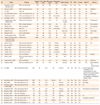Abstract
Objective
Methods
Results
Conclusions
Figures and Tables
 | Figure 1Study flowchart showing the identification and selection of eligible studies.ABO-OGS, Objective Grading System (OGS) proposed by the American Board of Orthodontics.
|
 | Figure 3Overall pooling for occlusal outcomes of fixed appliance (FA) treatment assessed using the Orthodontic Grading System proposed by the American Board of Orthodontics Mean Orthodontic Grading System scores and their corresponding 95% confidence intervals (CIs) for each included study are given as boxes with horizontal lines, respectively. The weighted pooled summary estimates with and their corresponding 95% CIs for the two subgroups or overall are given as diamonds. Horizontal lines at the diamonds represent the 95% prediction that gives a range of possible values to be clinically seen, while incorporating existing heterogeneity. |
 | Figure 4Overall pooling for the fixed appliance (FA) treatment duration in months. Mean treatment durations and their corresponding 95% confidence intervals (CIs) for each included study are given as boxes with horizontal lines, respectively. The weighted pooled summary estimates with and their corresponding 95% CIs for the two subgroups or overall are given as diamonds. Horizontal lines at the diamonds represent the 95% prediction that gives a range of possible values to be clinically seen, while incorporating existing heterogeneity. |
Table 1
Characteristics of the studies included in our systematic review assessing the occlusal outcomes and duration of orthodontic fixed appliance treatment

Data modifications according to the eligibility of the included reports was as follows.
(i) Pulfer 2009 was excluded from the descriptives because it drew upon the data of Hsieh 2005 and Knierim 2006 to pool them together.
(i) Pulfer 2009 was excluded from the descriptives because it drew upon the data of Hsieh 2005 and Knierim 2006 to pool them together.
(ii) Junqueira 2012 and Mendes 2012 were judged to have mostly overlapping patients; only data from Mendes 2012 are reported, which were the more extensive of the two.
(iii) Anthopoulou 2014 and Mislik 2016 had overlapping patient populations where different factors were assessed. The demographics of Anthopoulou 2014 are reported here.
(iv) Akinci Cansunar 2014, Cansunar 2014, and Cansunar 2016 were judged to have mostly overlapping patients in their report. Data from Akinci Cansunar 2014 are reported here.
(v) Pinskaya 2004 and Hsieh 2005 were omitted as they included both labial and lingual appliances.
(vi) Only a subgroup of patients originating from the Okayama University was included from the Deguchi 2005 study, because the cohort from Indiana University was described in multiple other reports.
*Patient groups pertaining to treatment alternatives noneligible for this review (aligners, lingual appliances, computer- or corticotomy-assisted orthodontics) were excluded.
†Intervention groups were pooled and not separately assessed because of the retrospective nature of the included studies.
‡Some reported in different reports on the same cohort.
Ex, Extraction; DI, discrepancy index; OGS, Objective Grading System; Tx, treatment; FA, fixed appliances; uni, University; NR, not reported; Cl., class; div, division; Int, intervention; Ex, extraction treatment; Non-Ex, nonextraction treatment; FFA, fixed functional appliance; TBO, Thai Board of Orthodontics; HG, headgear; RME, rapid maxillary expansion.
Table 2
Results of the meta-analyses for the primary (OGS score) and secondary (treatment duration) outcomes of orthodontic fixed appliance (FA) treatment

Table 3
Results of the meta-analyses regarding the effect of characteristics from included comparative case–control studies reporting one-phase fixed appliance treatment on the primary (OGS score) and secondary outcome (treatment duration)

Table 4
Methodological overview of comparison-specific characteristics obtained from of identified case-control studies

*Mendes et al. (2012) was excluded because patients were matched in terms of the final ABO OGS score.
CB, Conventional brackets; DI, discrepancy index; Ex, extraction treatment; Non-Ex, nonextraction treatment; RCT, randomized clinical trial; MBT, McLaughlin–Bennett–Trevisi; SE, standard edgewise; ABO, American Board of Orthodontics; OGS, Objective Grading System.




 PDF
PDF ePub
ePub Citation
Citation Print
Print



 XML Download
XML Download